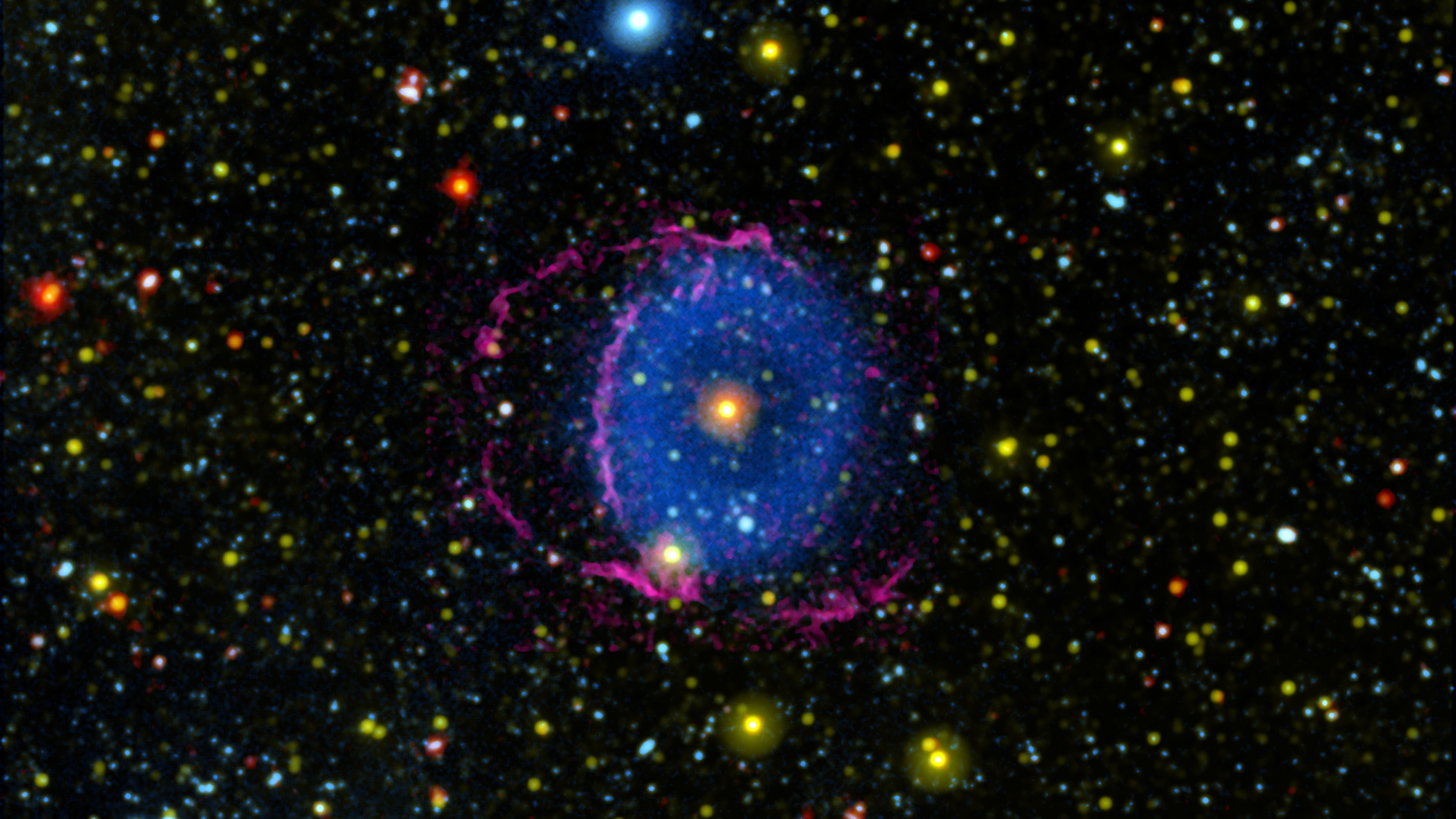The dazzling Blue Ring Nebula puzzled scientists for 16 years — and now they finally understand why
Scientists have uncovered new evidence in the mysterious fluorescent debris of the Blue Ring Nebula that may explain how the strange structure formed.
The Blue Ring Nebula harbors a central star, known as TYC 2597-735-1. An unusual ultraviolet ring surrounds the star, which astronomers first observed in 2004 using NASA's now-defunct Galaxy Evolution Explorer (GALEX) space telescope. Until now, the formation of this peculiar ring — which is actually invisible ultraviolet light that has been color-coded blue in the telescope images — has largely remained a mystery.
"Every time we thought we had this thing figured out, something would tell us, 'No, that's not right,'" Mark Seibert, an astrophysicist with the Carnegie Institution for Science, a member of the GALEX team and a co-author on the new research, said in a statement. "That's a scary thing as a scientist. But I also love how unique this object is, and the effort that so many people put in to figure it out."
Related: Gallery: Strange nebula shapes, what do you see?

Using the W. M. Keck Observatory in Hawaii, researchers found that the blue ring is actually the base of a cone-shaped cloud of glowing molecular hydrogen that extends away from the central star, toward Earth. The new observations also show a second cone-shaped cloud that extends from the star in the opposite direction.
The bases of the cone-shaped clouds appear to overlap when viewed from Earth, creating the ring shape around the star, Christopher Martin, a physicist at the California Institute of Technology (Caltech) and former principal investigator of GALEX, said in a news conference held digitally on Tuesday (Nov. 17), before the research was made public.
The scientists behind the new research believe that the clouds of fluorescent debris formed after a sunlike star collided with and consumed a smaller stellar companion only a few thousand years ago. The recent observations capture a never-before-seen evolutionary phase of a stellar collision.
Get the Space.com Newsletter
Breaking space news, the latest updates on rocket launches, skywatching events and more!
"The merging of two stars is fairly common, but they quickly become obscured by lots of dust as the ejecta from them expands and cools in space, which means we can't see what has actually happened," Keri Hoadley, lead author of the study and a physicist at Caltech, said in the statement.
The timing of the new observations was critical in helping scientists understand the phenomenon. "It's like catching sight of a baby when it first walks," Don Neill, an astrophysicist at Caltech and a GALEX team member, said in the statement. "If you blink, you might miss it."
It was that timing that let the researchers really see what was going on. "We think this object represents a late stage of these transient events, when the dust finally clears and we have a good view," Hoadley said. "But we also caught the process before it was too far along; after time, the nebula will dissolve into the interstellar medium, and we would not be able to tell anything happened at all."
The stellar collision ejected a cloud of hot debris into space. As the debris flew outward, it created a shock wave that, in turn, heated up hydrogen molecules in the debris cloud, producing the ultraviolet emissions scientists first observed back in 2004.
The researchers also used archived data from NASA's Spitzer Space Telescope and the Wide-field Survey Explorer (WISE), which revealed an excess of infrared emissions around the central star of the Blue Ring Nebula. These observations suggest that the star is surrounded by a disk of dust that absorbs the star's light and then reradiates in the infrared. The researchers believe that this disk cut the debris cloud surrounding the star in half, creating the two cone-shaped clouds that extend in opposite directions.
The findings were published today (Nov. 18) in the journal Nature.
Follow Samantha Mathewson @Sam_Ashley13. Follow us on Twitter @Spacedotcom and on Facebook.
Join our Space Forums to keep talking space on the latest missions, night sky and more! And if you have a news tip, correction or comment, let us know at: community@space.com.

Samantha Mathewson joined Space.com as an intern in the summer of 2016. She received a B.A. in Journalism and Environmental Science at the University of New Haven, in Connecticut. Previously, her work has been published in Nature World News. When not writing or reading about science, Samantha enjoys traveling to new places and taking photos! You can follow her on Twitter @Sam_Ashley13.









